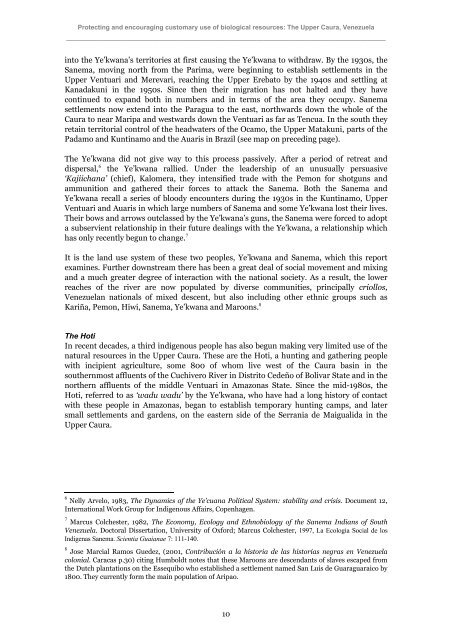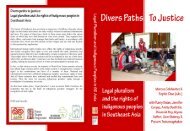The Upper Caura, Venezuela - Forest Peoples Programme
The Upper Caura, Venezuela - Forest Peoples Programme
The Upper Caura, Venezuela - Forest Peoples Programme
Create successful ePaper yourself
Turn your PDF publications into a flip-book with our unique Google optimized e-Paper software.
Protecting and encouraging customary use of biological resources: <strong>The</strong> <strong>Upper</strong> <strong>Caura</strong>, <strong>Venezuela</strong>_________________________________________________________________________________________into the Ye’kwana’s territories at first causing the Ye’kwana to withdraw. By the 1930s, theSanema, moving north from the Parima, were beginning to establish settlements in the<strong>Upper</strong> Ventuari and Merevari, reaching the <strong>Upper</strong> Erebato by the 1940s and settling atKanadakuni in the 1950s. Since then their migration has not halted and they havecontinued to expand both in numbers and in terms of the area they occupy. Sanemasettlements now extend into the Paragua to the east, northwards down the whole of the<strong>Caura</strong> to near Maripa and westwards down the Ventuari as far as Tencua. In the south theyretain territorial control of the headwaters of the Ocamo, the <strong>Upper</strong> Matakuni, parts of thePadamo and Kuntinamo and the Auaris in Brazil (see map on preceding page).<strong>The</strong> Ye’kwana did not give way to this process passively. After a period of retreat anddispersal, 6 the Ye’kwana rallied. Under the leadership of an unusually persuasive‘Kajiichana’ (chief), Kalomera, they intensified trade with the Pemon for shotguns andammunition and gathered their forces to attack the Sanema. Both the Sanema andYe’kwana recall a series of bloody encounters during the 1930s in the Kuntinamo, <strong>Upper</strong>Ventuari and Auaris in which large numbers of Sanema and some Ye’kwana lost their lives.<strong>The</strong>ir bows and arrows outclassed by the Ye’kwana’s guns, the Sanema were forced to adopta subservient relationship in their future dealings with the Ye’kwana, a relationship whichhas only recently begun to change. 7It is the land use system of these two peoples, Ye’kwana and Sanema, which this reportexamines. Further downstream there has been a great deal of social movement and mixingand a much greater degree of interaction with the national society. As a result, the lowerreaches of the river are now populated by diverse communities, principally criollos,<strong>Venezuela</strong>n nationals of mixed descent, but also including other ethnic groups such asKariña, Pemon, Hiwi, Sanema, Ye’kwana and Maroons. 8<strong>The</strong> HotiIn recent decades, a third indigenous people has also begun making very limited use of thenatural resources in the <strong>Upper</strong> <strong>Caura</strong>. <strong>The</strong>se are the Hoti, a hunting and gathering peoplewith incipient agriculture, some 800 of whom live west of the <strong>Caura</strong> basin in thesouthernmost affluents of the Cuchivero River in Distrito Cedeño of Bolivar State and in thenorthern affluents of the middle Ventuari in Amazonas State. Since the mid-1980s, theHoti, referred to as ‘wadu wadu’ by the Ye’kwana, who have had a long history of contactwith these people in Amazonas, began to establish temporary hunting camps, and latersmall settlements and gardens, on the eastern side of the Serrania de Maigualida in the<strong>Upper</strong> <strong>Caura</strong>.6 Nelly Arvelo, 1983, <strong>The</strong> Dynamics of the Ye’cuana Political System: stability and crisis. Document 12,International Work Group for Indigenous Affairs, Copenhagen.7 Marcus Colchester, 1982, <strong>The</strong> Economy, Ecology and Ethnobiology of the Sanema Indians of South<strong>Venezuela</strong>. Doctoral Dissertation, University of Oxford; Marcus Colchester, 1997, La Ecologia Social de losIndigenas Sanema. Scientia Guaianae 7: 111-140.8 Jose Marcial Ramos Guedez, (2001, Contribución a la historia de las historias negras en <strong>Venezuela</strong>colonial. Caracas p.30) citing Humboldt notes that these Maroons are descendants of slaves escaped fromthe Dutch plantations on the Essequibo who established a settlement named San Luis de Guaraguaraico by1800. <strong>The</strong>y currently form the main population of Aripao.10
















